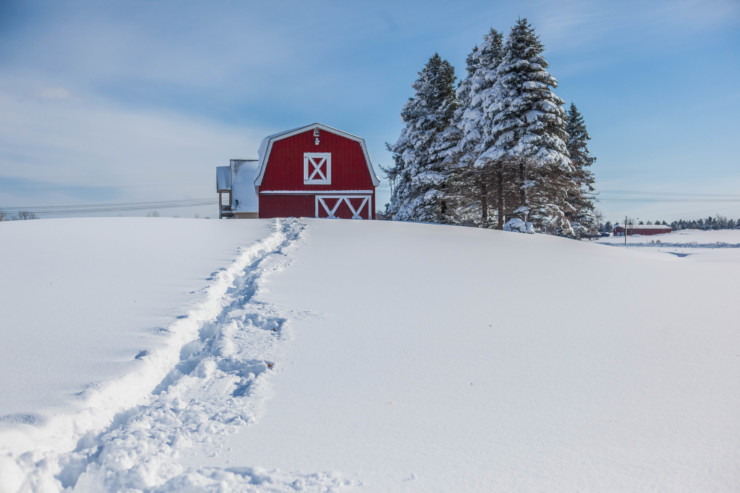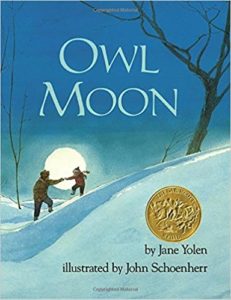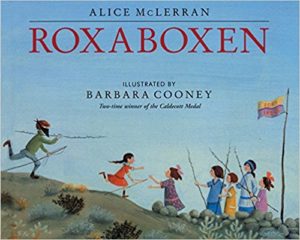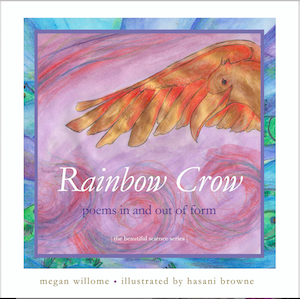In Owl Moon, love looks like a father and daughter owling under a bright shining moon.
“When you go owling / you don’t need words / or warm / or anything but hope. / That’s what Pa says.”
You’ll notice I wrote that sentence with line breaks, as if it were a poem. That was deliberate. This story feels like a poem. It’s only 752 words.
The illustration below that sentence is of a father carrying his daughter through the snow, toward home. That’s love. This love doesn’t need words; it’s reflected in every action, every quiet footstep, every animal hidden in the illustrations, to which you need to pay attention. (How many hidden animals can you find?)
The author of Owl Moon, Jane Yolen, who is also a poet, is prolific. She’s written more than 365 books, some for children, some YA, some fantasy, some sci-fi, and some historical fiction. Her latest is The Emerald Circus, short stories that reimagine other tales. Her writing has won many, many awards, including two Nebulas.
Speaking of picture books, Yolen says on her website, “The demands of picture books are so different from the demands of novels. There is a subtle dance between art and text which cannot be entirely planned for when the writer begins. A picture book writer needs to remain as supple as a dancer in order to accommodate a partner (the illustrator). It is the book — not just text or art — that has to be whole.”
She found a good dancing partner in illustrator John Schoenherr. Their collaboration earned this book a Caldecott Medal in 1988. Schoenherr passed away in 2010, but he illustrated more than forty books, among the most notable, Julie of the Wolves, by Jean Craighead George, and the original illustrations for Frank Herbert’s Dune.
Owl Moon is a quiet story, Although there are sounds — a train whistle, a farm dog, a second dog, Pa making the call of the Great Horned Owl — this story is “quiet as a dream.” And yet, the hardest part about going owling is being quiet.
“But I never called out. / If you go owling / you have to be quiet, / that’s what Pa always says.” And a few pages later, “But I never said a word. / If you go owling / you have to be quiet / and make your own heat.” Later, the child sighs, “and Pa held up his hand / at the sound,” as if to say, Hush.
“I had been waiting / to go owling with Pa / for a long, long time.”
Owling appears to be a tradition in this family. We know this child has brothers who have told her about owling. But we don’t know where the family lives. We don’t know how many people are in the family. We don’t know how the owling tradition began or at what age a child gets to go.
But even without those seemingly pertinent details, there’s still a lot to notice — how the cold feels, how the scarf feels, what Pa’s shadow and the child’s shadow look like. This child pays attention. I get the feeling that even if they didn’t see the owl, the excursion would have been a success.
Noticing. Paying attention. Those words always make me think of Mary Oliver, who uses them over and over again in her poems. In fact, knowing how much Oliver loves going into the woods, I like to imagine this child is a young Mary Oliver.
How do we teach children about quiet? Not how to hush in a classroom, but how to treasure quietness so that other sounds, other sights, other sensations, emerge. It seems some sort of outdoor activity is required.
And notice what creature the father and daughter have gone outside to see — an owl. Owls are in the same family as hawks and eagles. The Great Horned Owl of this story doesn’t eat birdseed. The Cornell Lab of Ornithology describes its diet this way: “This powerful predator can take down birds and mammals even larger than itself, but it also dines on daintier fare such as tiny scorpions, mice, and frogs.” That’s the creature they are going out to see in the moonlight. It’s not a cute and fuzzy bunny; it eats cute and fuzzy bunnies.
“When you go owling / you have to be brave.”
The child is brave, and I think she is braver because she’s with her father. Sometimes, in order to do something important, you have to stay up past bedtime and bundle up and walk where “things / hide behind black trees / in the middle of the night.”
We see the faces of the parent and child looking at the owl before we see the owl. Their eyes are wide, and Pa’s mouth is open. Then we come to my favorite sentence: “For one minute, / three minutes, maybe even a hundred minutes, / we stared at one another.”
When you’re a child, three minutes might as well be a hundred minutes.
After they see the owl, Pa breaks the quiet and speaks, and although the child knows she can speak again, she doesn’t.
“But I was a shadow as we walked home.”
In her father’s arms, she’s still paying attention, even if she doesn’t realize it. On the last page, she’s clearly hugging her father, although she might say he was carrying her.
Which brings me to the movie Lady Bird. The title character can’t wait to graduate high school and leave Sacramento far, far behind. She’s confronted with the fact that she couldn’t have written such a good college essay about her hometown if she didn’t love it. After listening to Lady Bird rail against Sacramento for the entire movie, this revelation comes as a shock.
Sister Sarah Joan: You clearly love Sacramento.
Christine ‘Lady Bird’ McPherson: I do?
Sister Sarah Joan: You write about Sacramento so affectionately and with such care.
Christine ‘Lady Bird’ McPherson: I was just describing it.
Sister Sarah Joan: Well, it comes across as love.
Christine ‘Lady Bird’ McPherson: Sure, I guess I pay attention.
Sister Sarah Joan: Don’t you think maybe they are the same thing? Love and attention?
Yes, Sister Sarah Joan, I think they are. And I think Jane Yolen would agree.
_______________
The next Children’s Book Club will meet Friday, March 9: We will read Roxaboxen, written by Alice McLerran and illustrated by Barbara Cooney.
Photo by Anthony Quintano, Creative Commons via Flickr. Post by Megan Willome, author of The Joy of Poetry.
Browse more Children’s Book Club
“Megan Willome has captured the essence of crow in this delightful children’s collection. Not only do the poems introduce the reader to the unusual habits and nature of this bird, but also different forms of poetry as well.”
—Michelle Ortega, poet and children’s speech pathologist
- Perspective: The Two, The Only: Calvin and Hobbes - December 16, 2022
- Children’s Book Club: A Very Haunted Christmas - December 9, 2022
- By Heart: ‘The night is darkening round me’ by Emily Brontë - December 2, 2022




Monica Sharman says
Yes, a family tradition for sure. She has two sons and a daughter. Her husband was a very well known birder:
https://www.cics.umass.edu/news/archives/professor-emeritus-david-w-stemple-1937-2006
Megan Willome says
That’s fascinating, Monica. Thank you!
Sandra Heska King says
Hey, look at this. A book a day…
http://janeyolen.com/yolen365/
Megan Willome says
Yes, I found that with good ol’ Mr. Google.
Sandra Heska King says
I love Mr. Google. 🙂
Sandra Heska King says
Her dedication reads:
“For my husband, David,
who took all of your children owling.”
I could feel the snow and hear the quiet–though my dreams are seldom quiet. I heard the soft whoosh of snow falling off trees, though it wasn’t warm enough in the story for that to happen. The snow in this story was crispy. I know that sound, too. I spent most of my days alone in the woods when I was growing up, but I was too scared of it in the dark, being sure a bear would get me. I would have gone with my dad, though. All those shadows that stained the snow. Who knows what was lurking out there?
I loved the little gray footprints that followed them and the snow whiter than the milk in a cereal bowl. And I could feel the child’s physical cold–Yolen describes it well. But there was warmth, too. And hope. And love.
We’ve heard owls out in the “swamp.” I may try calling them next time. 🙂
And yay for Mary Oliver. And it seems Emily Dickinson made an appearance, too.
Megan Willome says
It seems the woods are a good place for poets. If an owl whoo’s back at you, please write about it.
I love that you noticed the gray footprints.
Dheepa Maturi says
Thank you for this beautiful article, Megan. I love the connections you made to Mary Oliver and your discussion of attention constituting love — it’s inspired me to start an essay on the topic!
While reading the book, I felt I was witnessing the imparting of life wisdom from father to child, now that the child has come of age and earned the privilege of owling.
• She learns that they might not find an owl at all during their walk. The lesson — sometimes, even after every possible effort, we can’t achieve what we want.
• She learns that you get cold and wet when you’re owling; your eyes become cloudy; you must make and preserve your own heat. The lesson — discomfort is part of life and must be borne — but beauty might lie on the other side of it.
• She learns that she must be brave. The lesson — courage means facing “what hides behind black trees” and continuing to move forward.
And then, after seeing her absorb all these difficult lessons of adulthood, I felt deep comfort and pleasure in seeing her shadow enveloped by her father’s and knowing she was being carried safely home.
Megan Willome says
So insightful, Dheepa. The discomfort she feels is an essential part of the owling experience, and as you said, we often have to experience discomfort on the path to beauty. And that line about how there might not be an owl at all: “My brothers all said / sometimes there’s an owl / and sometimes there isn’t.” Or, as the Stones said, “You can’t always get what you want.”
I’m happy to hear you are writing an essay about all of this!
Laurie Klein says
I love the voices in this book, and the pervasive hush seamlessly evoked by images and text. It’s a stillness deeper than weather or setting or time of night. I’m eavesdropping on a small rite of passage for this family. And the quiet, for me, is composed of multiple parts: woodland savvy, respect, risk, love, curiosity, wonder.
This story reopened good snow memories of my father and I annually creating and maintaining our skating rink. In fact, I wrote about the memory after reading Owl Moon several times. I’m deeply grateful you introduced me to this book, Megan. Thank you!
Megan Willome says
Laurie, I’m so happy that reading this book stirred you to write about a memory. I think that’s one of the superpowers of children’s books–they takes us back in time.
I also like your word “eavesdropping.” Yes, it’s almost like we’re one of those hidden animals in the illustrations, watching and listening.
Kortney Garrison says
Heidi Stemple, the girl in Owl Moon, is still counting owls: https://www.facebook.com/Owl-Count-527332320703345/ And writing children’s books! https://taralazar.com/2018/01/10/storystorm-2018-day-10-heidi-stemple/
Megan Willome says
Kortney, I had no idea!
Michelle Ortega says
I loved this rite of passage for the child who was finally old enough to go owling as her brothers did before her. My dad was a hunter, and in the spring he hunted turkeys. One Memorial Day weekend we were “up the Farm” in “New York State,” which is what we called the hunting cabin my father and his cousins owned. I accompanied my dad in the evening to find where the turkeys were roosting. Because they aren’t good flyers, turkeys spend most of the day climbing up the mountain, scratching around and eating. As they reach the top, they fly straight across to the treetops and sleep in the high branches. At dawn, they “fly” down from the trees to the bottom of the hill, using their wings more like parachutes than propellers, and start their foraging all over again. Hunters will call (my dad actually carved many, many of his own calls out of beautiful and rare wood he found) the turkeys in the evening to pinpoint where they will be in the morning for the hunt.
I remember my dad pointing out all of the markings in the woods, not just turkeys but fox and deer as well. He told me about being in the woods in the dark morning, as each of the species awakened with layers of song and sound, with the sky brightening and the song at a crescendo about an hour past sunrise. Just in time to go back to the cabin and have bacon and eggs for breakfast.
Megan Willome says
Michelle, this is a rich memory, so full of detail. I love that it happens in the “dark morning,” different from the moonlight of Owl Moon, but also similar.
And I’ve seen wild turkeys. The word “parachutes” is apropos.
Sharon A Gibbs says
I read this gorgeous book for the first time back in November. Jane’s language always entrances me with its gentle poetic style. Such a beautiful book to read out loud! If I were a child, this would definitely be one of my favorite bedtime stories.
After reading a children’s book, I sit with it to notice things like figurative language, sound devices, and underlying themes. (Thank you, L.L. Barkat 😉 )
My handwritten notes from Nov. 25th read, “special time with Dad,” “mutual trust,” “sharing knowledge,” “mystery,” “father leads, but at a child’s pace,” “risk”, and “safety.”
I love how, even with the sense of mystery and risk, they experience a mutual trust.
It feels so complete and comforting, like when parents tuck their young child into bed at night.
This book club opens doors to so many wonderful surprises, like the links about Heidi and David (who else wondered what happened to that little girl?), the book a day link, personal stories, inspiration, and deeper understanding. Who would have thought that eavesdropping could produce such a rich collection?
Megan Willome says
Sharon, I like your note that says, “father leads, but at a child’s pace.” So much wisdom in that.
Kortney Garrison says
Wanted to also point you toward the poem Things That Make Me Cry Instantly by Kimiko Hahn
https://books.google.com/books?id=FzAkAgAAQBAJ&pg=PA88&lpg=PA88&dq=Things+That+Make+Me+Cry+Instantly%E2%80%94+by+Kimiko+Hahn&source=bl&ots=8dyiJRO_2S&sig=Q5JiycLqBd0XvmYbBqX_TbPvMdQ&hl=en&sa=X&ved=0ahUKEwiEx7qQgrPZAhUG22MKHV_gCpcQ6AEIJzAA#v=onepage&q=Things%20That%20Make%20Me%20Cry%20Instantly%E2%80%94%20by%20Kimiko%20Hahn&f=false
Megan Willome says
Oh, thank you, Kortney!